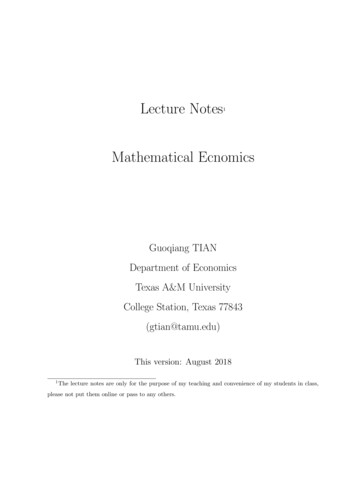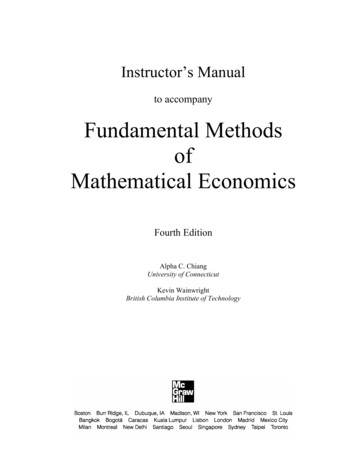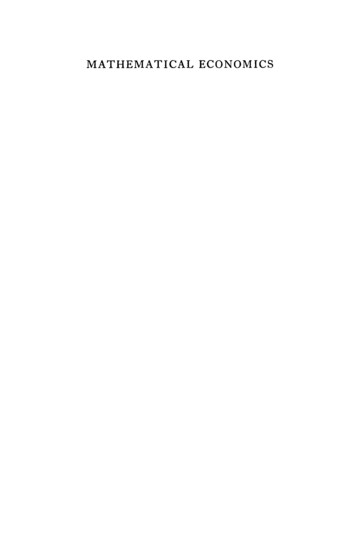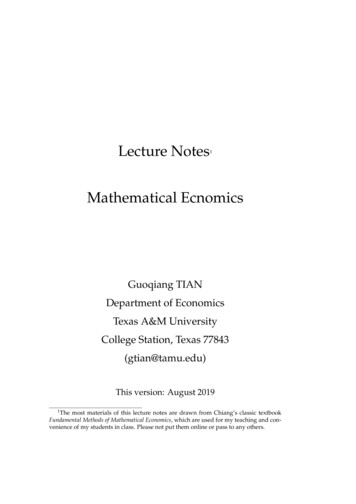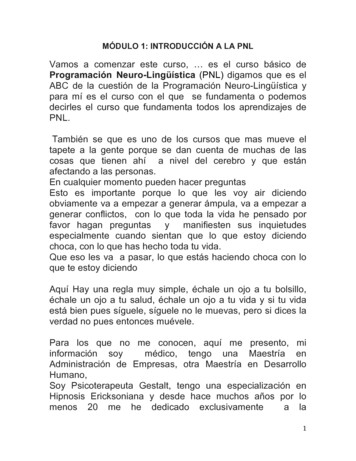
Transcription
FundamentaMethods ofMathematicalEconomicsFourth EditionAlpha C. ChiangProfessor EmeritusUniversity of ConnecticutKevin WainwrightBritish Columbia Institute ofTechnology andSimon Fraser UniversityMeGrawHillBoston Burr Ridge, IL Dubuque, IA Madison, Wl New York San Francisco St. LouisBangkok Bogota Caracas Kuala Lumpur Lisbon London Madrid Mexico CityMilan Montreal New Delhi Santiago Seoul Singapore Sydney Taipei Toronto
ContentsPART ONEPART TWOINTRODUCTION 1STATIC (OR EQUILIBRIUM)ANALYSIS 29Chapter 1The Nature of MathematicalEconomics 2Chapter 3Equilibrium Analysis in Economics 301.1 Mathematical versus Nonmathematical3.13.21.2Economics 2Mathematical Economics versusEconometrics 4Chapter 2Economic Models 5Ingredients of a MathematicalModel 5Variables, Constants, and Parameters 5Equations and Identities 62.2 The Real-Number System 72.3 The Concept of Sets 8Set Notation 9Relationships between Sets 9Operations on Sets 11Laws of Set Operations 12Exercise 2.3 142.4 Relations and Functions 15Ordered Pairs 15Relations and Functions 16Exercise 2.4 192.5 Types of Function 20 Constant Functions 20Polynomial Functions 20Rational Functions 21Nonalgebraic Functions 23A Digression on Exponents 23Exercise 2.5 242.6 Functions of Two or More IndependentVariables 252.7 Levels of Generality 273.32.13.43.5The Meaning of Equilibrium 30Partial Market Equilibrium—A LinearModel 31Constructing the Model 31Solution by Elimination of Variables 33Exercise 3.2 34Partial Market Equilibrium—A NonlinearModel 35Quadratic Equation versus QuadraticFunction 35The Quadratic Formula 36Another Graphical Solution 37Higher-Degree Polynomial Equations 38Exercise 3.3 40General Market Equilibrium 40Two-Commodity Market Model 41Numerical Example 42n-Commodity Case 43'Solution of a General-Equation System 44Exercise 3.4 45Equilibrium in National-Income Analysis 46Exercise 3.5 47Chapter 4Linear Models and Matrix Algebra484.1 Matrices and Vectors 494.2Matrices as Arrays 49Vectors as Special Matrices 50Exercise 4.1 51Matrix Operations 51Addition and Subtraction of Matrices 51Scalar Multiplication 52
xii4.34.44.54.64.7ContentsMultiplication of Matrices 53The Question of Division 56The S Notation 56Exercise 4.2 58Notes on Vector Operations 59Multiplication of Vectors59Geometric Interpretation of VectorOperations 60Linear Dependence 62Vector Space 63Exercise 4.3 65Commutative, Associative, and DistributiveLaws 67Matrix Addition 67Matrix Multiplication 68Exercise 4.4 69Identity Matrices and Null Matrices 70Identity Matrices 70Null Matrices 71Idiosyncrasies of Matrix Algebra 72Exercise 4.5 72Transposes and Inverses 73Properties ofTransposes 74Inverses and Their Properties 75Inverse Matrix and Solution ofLinear-Equation System 77Exercise 4.6 78Finite Markov Chains 78Special Case: Absorbing Mfirkov Chains 81Exercise 4.7 815.35.45.55.65.7Chapter 5Linear Models and Matrix Algebra(Continued) 825.15.2Conditions for Nonsingularity of a Matrix 82Necessary versus Sufficient Conditions 82Conditions for Nonsingularity 84Rank of a Matrix 85Exercise 5.1 87Test of Nonsingularity by Use ofDeterminant 88Determinants and Nonsingularity 88Evaluating a Third-Order Determinant 89Evaluating an nth-Order Determinant byLaplace Expansion 91Exercise 5.2 935.8Basic Properties of Determinants 94Determinantal Criterion forNonsingularity 96Rank of a Matrix Redefined 97Exercise 5.3 98Finding the Inverse Matrix 99Expansion of a Determinant by AlienCofactors 99Matrix Inversion 100-" Exercise 5.4 102Cramer's Rule 103Derivation of the Rule 103Note on Homogeneous-Equation Systems 105Solution Outcomes for a Linear-EquationSystem 106Exercise 5.5 107Application to Market and National-IncomeModels 107Market Model 107National-Income Model 108IS-LM Model: Closed Economy 109Matrix Algebra versus Elimination ofVariables 111Exercise 5.6 111Leontief Input-Output Models 112Structure of an Input-Output Model 112The Open Model 113A Numerical Example 115The Existence of Nonnegative Solutions 116Economic Meaning of the Hawkins-SimonCondition 118The Closed Model 119Exercise 5.7 120Limitations of Static Analysis 120PART THREECOMPARATIVE-STATICANALYSIS 123Chapter 6Comparative Statics and the Conceptof Derivative 1246.16.2The Nature of Comparative Statics 124Rate of Change and the Derivative 125The Difference Quotient 125
ContentsThe Derivative 126Exercise 6.2 1276.3 The Derivative and the Slope of a Curve 1286.4 The Concept of Limit 129Left-Side Limit and Right-Side Limit 129Graphical Illustrations 130Evaluation of a Limit 131Formal View of the Limit Concept 133Exercise 6.4 1356.5 Digression on Inequalities and Absolute sValues 136Rules of Inequalities 136Absolute Values and Inequalities 137Solution of an Inequality 138Exercise 6.5 1396.6 Limit Theorems 139Theorems Involving a Single Function 139Theorems Involving Two Functions 140Limit of a Polynomial Function 141 .Exercise 6.6 1416.7 Continuity and Differentiability of aFunction 141Continuity of a Function 141Polynomial and Rational Functions 142Differentiability of a Function 143Exercise 6.7 1467.3Chapter 78.17.47.57.6Chapter 8Comparative-Static Analysis ofGeneral-Function Models 178Rules of Differentiation and Their Usein Comparative Statics 1487.1 Rules of Differentiation for a Function ofOne Variable 148Constant-Function Rule 148Power-Function Rule 149Power-Function Rule Generalized 151Exercise 7.1 1527.2 Rules of Differentiation Involving Two orMore Functions of the Same Variable 152Sum-Difference Rule 152Product Rule 155Finding Marginal-Revenue Function fromAverage-Revenue Function 156Quotient Rule 158Relationship Between Marginal-Cost andAverage- Cost Functions 159Exercise 7.2 160Rules of Differentiation InvolvingFunctions of Different Variables 161Chain Rule 161Inverse-Function Rule 163Exercise 7.3 165Partial Differentiation 165Partial Derivatives 165Techniques of PartialDifferentiation 166Geometric Interpretation of PartialDerivatives 167Gradient Vector 168Exercise 7.4 169Applications to Comparative-StaticAnalysis 170Market Model 170National-Income Model 172Input-Output Model 173Exercise 7.5 .175Note on Jacobian Determinants 175Exercise 7.6 1778.28.38.48.5Differentials 179Differentials and Derivatives 179Differentials and Point Elasticity 181Exercise 8.1 184Total Differentials 184Exercise 8.2 186Rules of Differentials 187Exercise 8.3 189Total Derivatives 189Finding the Total Derivative 189A Variation on the Theme 191Another Variation on the Theme 192Some General Remarks 193Exercise 8.4 193Derivatives of Implicit Functions 194Implicit Functions 194Derivatives of Implicit Functions 196Extension to the Simultaneous-EquationCase 199Exercise 8.5 204xii
xiv8.6ContentsComparative Statics of General-FunctionModels 205Market Model 205Simultaneous-Equation Approach 207Use of Total Derivatives 209National-Income Model (IS-LM) 210Extending the Model: An OpenEconomy 213Summary of the Procedure 216Exercise 8.6 2178.7Limitations of Comparative Statics218PART FOUROPTIMIZATION PROBLEMS 219Chapter 9Optimization: A Special Variety ofEquilibrium Analysis 2209.19.2Optimum Values and Extreme Values 221Relative Maximum and Minimum:First-Derivative Test 222Relative versus Absolute ExtremumFirst-Derivative Test 223Exercise 9.2 2269.39.49.5Second and Higher Derivatives222227Derivative of a Derivative 227Interpretation of the Second Derivative 229An Application 231Attitudes toward Risk 231Exercise 9.3 233Second-Derivative Test 233Necessary versus Sufficient Conditions 234Conditions for Profit Maximization 235Coefficients of a Cubic Total-CostFunction 238Upward-Sloping Marginal-RevenueCurve 240Exercise 9.4 241Maclaurin and Taylor Series242Maclaurin Series of a PolynomialFunction 242Taylor Series of a Polynomial Function 244Expansion of an Arbitrary Function 245Lagrange Form of the Remainder 248Exercise 9.5 2509.6Mh-Derivative Test for Relative Extremum ofa Function of One Variable 250Taylor Expansion and Relative Extremum 250Some Specific Cases 251Nth-Derivative Test 253Exercise 9.6 254Chapter 10Exponential and LogarithmicFunctions 25510.1 The Nature of Exponential Functions 256Simple Exponential Function 256Graphical Form 256Generalized Exponential Function 25 7A Preferred Base 259Exercise 10.1 26010.2 Natural Exponential Functions and theProblem of Growth 260The Number e 260An Economic Interpretation ofe 262Interest Compounding and the FunctionAe" 262Instantaneous Rate of Growth 263Continuous versus Discrete Growth 265Discounting and Negative Growth 266Exercise 10.2 26710.3 Logarithms267The Meaning of Logarithm 267Common Log and Natural Log 268Rules of Logarithms 269An Application 271Exercise 10.3 27210.4 Logarithmic Functions 272Log Functions and Exponential Functions 272The Graphical Form 273Base Conversion 274Exercise 10.4 27610.5 Derivatives of Exponential and LogarithmicFunctions 277Log-Function Rule 277Exponential-Function Rule 278The Rules Generalized 278The Case of Base b 280Higher Derivatives 280An Application 281Exercise 10.5 282
Contents10.6 Optimal Timing 282A Problem of Wine Storage 282Maximization Conditions 283A Problem of Timber Cutting 285Exercise 10.6 28610.7 Further Applications of Exponential andLogarithmic Derivatives 286Finding the Rate of Growth 286Rate of Growth of a Combination ofFunctions 287Finding the Point Elasticity 288Exercise 10.7 290Chapter 11The Case of More than One ChoiceVariable 29111.1 The Differential Version of OptimizationConditions 291First-Order Condition 291Second-Order Condition 292Differential Conditions versus DerivativeConditions 29311.2 Extreme Values of a Function of TwoVariables 293First-Order Condition 294Second-Order Partial Derivatives 295Second-Order Total Differential 297Second-Order Condition 298Exercise 11.2 30011.3 Quadratic Forms—An Excursion 301Second-Order Total Differential as a QuadraticForm 301Positive and Negative Definiteness 302Determinantal Test for SignDefiniteness 302Three-Variable Quadratic Forms 305n-Variable Quadratic Forms 307Characteristic-Root Test for SignDefiniteness 307Exercise 11.3 31211.4 Objective Functions with More than TwoVariables 313First-Order Condition for Extremum 313Second-Order Condition 313n-Variable Case 316Exercise 11.4 317xv11.5 Second-Order Conditions in Relation toConcavity and Convexity 318Checking Concavity and Convexity 320Differentiable Functions 324Convex Functions versus Convex Sets 327Exercise 11.5 33011.6 Economic Applications 331Problem of a Multiproduct Firm 331Price Discrimination 333-Input Decisions of a Firm 336Exercise 11.6 34111.7 Comparative-Static Aspects ofOptimization 342Reduced-Form Solutions 342General-Function Models 343Exercise 11.7 345Chapter 12Optimization with EqualityConstraints 34712.1 Effects of a Constraint 34712.2 Finding the Stationary Values 349Lagrange-Multiplier Method 350Total-Differential Approach 352An Interpretation of the LagrangeMultiplier 353n- Variable and Multiconstraint Cases 354Exercise 12.2 35512.3 Second-Order Conditions 356Second-Order Total Differential 356Second-Order Conditions 357The Bordered Hessian 358n-Variable Case 361Multiconstraint Case 362Exercise 12.3 36312.4 Quasiconcavity and Quasiconvexity 364Geometric Characterization 364Algebraic Definition 365Differentiable Functions 368A Further Look at the Bordered Hessian 3 71A bsolute versus Relative Extrema 3 72Exercise 12.4 37412.5 Utility Maximization and ConsumerDemand 374First-Order Condition 375Second-Order Condition 376
xviContentsComparative-Static Analysis 378Proportionate Changes in Pricesand Income 381Exercise 12.5 38212.6 Homogeneous Functions 383Linear Homogeneity 383Cobb-Douglas Production Function 386Extensions of the Results 388Exercise 12.6 38912.7 Least-Cost Combination of Inputs 390First-Order Condition 390Second-Order Condition 392The Expansion Path 392Homothetic Functions 394Elasticity of Substitution 396CES Production Function 397Cobb-Douglas Function as a Special Case ofthe CES Function 399Exercise 12.7 401Chapter 13Further Topics in OptimizationThe Arrow-Enthoven Sufficiency Theorem:Quasiconcave Programming 425A Constraint-Qualification Test 426Exercise 13.4 42713.5 Maximum-Value Functions and theEnvelope Theorem 428The Envelope Theorem for UnconstrainedOptimization 428The Profit Function 429. Reciprocity Conditions 430The Envelope Theorem for ConstrainedOptimization 432Interpretation of the Lagrange Multiplier 43413.6 Duality and the Envelope Theorem 435The Primal Problem 435The Dual Problem 436Duality 436Roy's Identity 43 7Shephard's Lemma 438Exercise 13.6 441 x13.7 Some Concluding Remarks 44240213.1 Nonlinear Programming and Kuhn-TuckerConditions 402Step I: Effect of NonnegativityRestrictions 403Step 2: Effect of Inequality Constraints 404Interpretation of the Kuhn-TuckerConditions 408The n-Variable, m-Constraint Case 409Exercise 13.1 41113.2 The Constraint Qualification 412Irregularities at Boundary Points 412The Constraint Qualification 415Linear Constraints 416Exercise 13.2 41813.3 Economic Applications 418War-Time Rationing 418Peak-Load Pricing 420Exercise 13.3 42313.4 Sufficiency Theorems in NonlinearProgramming 424The Kuhn-Tucker Sufficiency Theorem:Concave Programming 424PART FIVEDYNAMIC ANALYSIS 443Chapter 14Economic Dynamics and IntegralCalculus 44414.1 Dynamics and Integration 44414.2 Indefinite Integrals 446The Nature of Integrals 446Basic Rules of Integration 447Rules of Operation 448Rules Involving Substitution 451Exercise 14.2 45314.3 Definite Integrals 454Meaning of Definite Integrals 454A Definite Integral as an Area under aCurve 455Some Properties of Definite Integrals 458Another Look at the IndefiniteIntegral 460Exercise 14.3 460
Contents14.4 Improper Integrals 461Infinite Limits of Integration 461Infinite Integrand 463Exercise 14.4 46414.5 Some Economic Applications ofIntegrals 464From a Marginal Function to a TotalFunction 464Investment and Capital Formation 465Present Value of a Cash Flow 468Present Value of a Perpetual Flow 470Exercise 14.5 47014.6 Domar Growth Model 471The Framework 471Finding the Solution 472The Razor's Edge 473Exercise 14.6 474Chapter 15Continuous Time: First-OrderDifferential Equations 47515.1 First-Order Linear Differential Equationswith Constant Coefficient and ConstantTerm 475The Homogeneous Case 476The Nonhomogeneous Case 476Verification of the Solution 478Exercise 15.1 47915.2 Dynamics of Market Price 479The Framework 480The Time Path 480The Dynamic Stability of Equilibrium 481An Alternative Use of the Model 482Exercise 15.2 48315.3 Variable Coefficient and Variable Term 483The Homogeneous Case 484The Nonhomogeneous Case 485Exercise 15.3 48615.4 Exact Differential Equations 486Exact Differential Equations 486Method of Solution 487Integrating Factor 489Solution of First-Order Linear DifferentialEquations 490Exercise 15.4 491xvii15.5 Nonlinear Differential Equations of the FirstOrder and First Degree 492Exact Differential Equations 492Separable Variables 492Equations Reducible to the Linear Form 493Exercise 15.5 49515.6 The Qualitative-Graphic Approach 495The Phase Diagram 495Types of Time Path 496Exercise 15.6 49815.7 Solow Growth Model 498The Framework 498A Qualitative-Graphic Analysis 500A Quantitative Illustration 501Exercise 15.7 502Chapter 16Higher-Order DifferentialEquations 50316.1 Second-Order Linear Differential Equationswith Constant Coefficients and ConstantTerm 504The Particular Integral 504The Complementary Function 505The Dynamic Stability of Equilibrium 510Exercise 16.1 51116.2 Complex Numbers and CircularFunctions 511Imaginary and Complex Numbers 511Complex Roots 512Circular Functions 513Properties of the Sine and CosineFunctions 515Euler Relations 517Alternative Representations of ComplexNumbers 519Exercise 16.2 5211 6 . 3 Analysis of the Complex-RootCase 522The Complementary Function 522An Example of Solution 524- The Time Path 525The Dynamic Stability ofEquilibrium 527Exercise 16.3 527
xviiiContents16.4 A Market Model with PriceExpectations 527Price Trend and Price Expectations 52 7A Simplified Model 528The Time Path of Price 529Exercise 16.4 53216.5 The Interaction of Inflation andUnemployment 532The Phillips Relation 532The Expectations-Augmented PhillipsRelation 533The Feedback from Inflation toUnemployment 534The Time Path ofn 534Exercise 16.5 53716.6 Differential Equations with a VariableTerm 538Method of Undetermined Coefficients 538A Modification 539Exercise 16.6 54016.7 Higher-Order Linear DifferentialEquations 540Finding the Solution 540Convergence and the Routh Theorem 542Exercise 16.7 543Chapter 17Discrete Time: First-Order DifferenceEquations 54417.1 Discrete Time, Differences, and DifferenceEquations 54417.2 Solving a First-Order DifferenceEquation 546 Iterative Method 546General Method 548Exercise 17.2 55117.3 The Dynamic Stability of Equilibrium 551The Significance of b 551The Role of A 553Convergence to Equilibrium 554Exercise 17.3 55417.4 The Cobweb Model 555The Model 555The Cobwebs 556Exercise 17.4 55817.5 A Market Model with Inventory 559The Model 559The Time Path 560Graphical Summary of the Results 561Exercise 17.5 56217.6 Nonlinear Difference Equations—The Qualitative-Graphic Approach 562Phase Diagram 562Types of Time Path 564. .- A Market with a Price Ceiling 565Exercise 17.6 567Chapter 18Higher-Order Difference Equations56818.1 Second-Order Linear Difference Equationswith Constant Coefficients and ConstantTerm 569Particular Solution 569Complementary Function 570The Convergence of the Time Path 573Exercise 18.1 57518.2 Samuelson Multiplier-AccelerationInteraction Model 576The Framework 576The Solution 577Convergence versus Divergence 578A Graphical Summary 580Exercise 18.2 58118.3 Inflation and Unemployment in DiscreteTime 581The Model 581The Difference Equation in p 582The Time Path ofp 583The Analysis ofU 584The Long-Run Phillips Relation 585Exercise 18.3 58518.4 Generalizations to Variable-Term andHigher-Order Equations 586Variable Term in the Form of cm' 586Variable Term in the Form ct" 587Higher-Order Linear DifferenceEquations 588Convergence and the SchurTheorem 589Exercise 18.4 591
Contents xixChapter 19Simultaneous Differential Equations andDifference Equations 59219.1 The Genesis of Dynamic Systems 592Interacting Patterns of Change 592The Transformation of a High-Order DynamicEquation 59319.2 Solving Simultaneous DynamicEquations 594Simultaneous Difference Equations 594Matrix Notation 596Simultaneous Differential Equations 599Further Comments on the CharacteristicEquation 601Exercise 19.2 60219.3 Dynamic Input-Output Models 603Time Lag in Production 603Excess Demand and Output Adjustment 605Capital Formation 607Exercise 19.3 60819.4 The Inflation-Unemployment Model OnceMore 609Simultaneous Differential Equations 610Solution Paths 610Simultaneous Difference Equations 612Solution Paths 613Exercise 19.4 61419.5 Two-Variable Phase Diagrams 614The Phase Space 615The Demarcation Curves 615Streamlines 617Types of Equilibrium 618Inflation and Monetary Rule a la Obst 620Exercise 19.5 62319.6 Linearization of a Nonlinear DifferentialEquation System 623Taylor Expansion and Linearization 624The Reduced Linearization 625Local Stability Analysis 625Exercise 19.6 629Chapter 20Optimal Control Theory63120.1 The Nature of Optimal Control 631Illustration: A Simple MacroeconomicModel 632Pontryagin s Maximum Principle 63320.2 Alternative Terminal Conditions 639Fixed Terminal Point 639Horizontal Terminal Line 639Truncated Vertical Terminal Line 639Truncated Horizontal Terminal Line 640Exercise 20.2 64320.3 Autonomous Problems 64420.4 Economic Applications 645Lifetime Utility Maximization 645Exhaustible Resource 647Exercise 20.4 64920.5 Infinite Time Horizon 649Neoclassical Optimal Growth Model 649The Current-Value Hamiltonian 651Constructing a Phase Diagram 652Analyzing the Phase Diagram 65320.6 Limitations of Dynamic Analysis 654The Greek Alphabet 655Mathematical Symbols 656A Short Reading List 659Answers to Selected Exercises 662Index 677
The Nature of Mathematical Economics 2 1.1 Mathematical versus Nonmathematical Economics 2 1.2 Mathematical Economics versus Econometrics 4 Chapter 2 Economic Models 5 2.1 Ingredients of a Mathematical Model 5 Variables, Constants, and Parameters 5 Equations and Identities 6 2.2 The Real-Number System 7 2.3 The Concept of Sets 8 Set Notation 9


